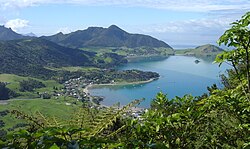
The Northland Region is the northernmost of New Zealand's 16 local government regions. New Zealanders sometimes refer to it as the Winterless North because of its mild climate all throughout the year. The main population centre is the city of Whangārei, and the largest town is Kerikeri. At the 2018 New Zealand census, Northland recorded a population growth spurt of 18.1% since the previous 2013 census, placing it as the fastest growing region in New Zealand, ahead of other strong growth regions such as the Bay of Plenty Region and Waikato.

Kaipara District is a territorial authority district in the Northland Region of New Zealand.

The Far North District is the northernmost territorial authority district of New Zealand, consisting of the northern part of the Northland Peninsula in the North Island. It stretches from North Cape / Otou and Cape Reinga / Te Rerenga Wairua in the north, down to the Bay of Islands, the Hokianga and the town of Kaikohe.
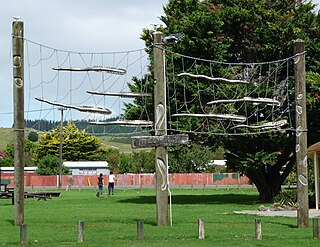
Moerewa is a small town in the Northland Region of the North Island of New Zealand. It is located close to the Bay of Islands five kilometres to the west of Kawakawa.
Ruakākā is a small town in the north of New Zealand approximately 30 kilometres south of Whangārei in the Bream Bay area. Originally a small beachside community, Ruakākā saw development in the 1980s as a result of the expansion of the nearby Marsden Point, New Zealand's sole oil refinery. A recently established timber processing plant at Marsden Point has further stimulated growth.
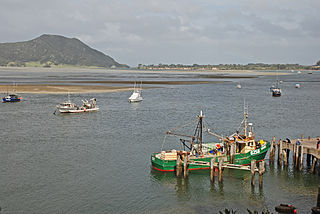
Pukenui is a locality on the southwest side of Houhora Harbour on the Aupouri Peninsula of Northland, New Zealand. State Highway 1 runs through it. The name means "large hill" in the Māori language.

Hikurangi is a settlement in Northland, New Zealand. The city of Whangārei is 17 km (11 miles) to the south, and Kawakawa is 39 km (24 miles) northwest. The Glenbervie Forest is southeast of the settlement. State Highway 1 once passed through the town, but now bypasses it to the west. Mount Hikurangi is a volcanic dome rising 365 metres (1,198 ft) to the west of the town. It is 1.2 million years old, and part of the Harbour Fault which also includes Parakiore, near Kamo, and Parihaka in Whangarei.
Maungatapere is a settlement in Northland, New Zealand. State Highway 14 runs through it. Whangārei is 11 km to the east, and Tangiteroria is 18 km to the south west. The settlement takes its name from a rounded volcanic peak of the same name that lies to the southwest, and has a summit 359 metres above sea level.

Ngunguru is a coastal settlement in Northland, New Zealand, 26 kilometres (16 mi) north-east of Whangārei. The Ngunguru River flows between the settlement and a long low sandspit into Ngunguru Bay, which stretches southwards. North of Ngunguru are Tutukaka and Matapouri. Just off the Ngunguru coast are the Poor Knights Islands, a protected marine reserve.

One Tree Point is a settlement on the southern side of Whangārei Harbour in Northland, New Zealand. The settlement includes the Marsden Point Marina.

Whangārei Heads is a locality and volcanic promontory on the northern side of the Whangārei Harbour in Northland, New Zealand. Whangārei is 29 km (18 mi) to the north-west, and Ocean Beach is 8 km (5.0 mi) to the south-east, with Taurikura between the two. Mount Manaia rises to 420 metres to the east.

Whangaruru is a rural community and harbour on the east coast of Northland, New Zealand. Mokau, Helena Bay, Whakapara, Hikurangi and Whangarei are to the south and the Bay of Islands is to the northwest.
Whangarei District Council is the territorial authority for the Whangarei District of New Zealand. The council consists of the mayor of Whangarei and 13 ward councillors, and is led by the mayor. Vince Cocurullo has been the mayor since 2022.

Pataua is a settlement in Northland Region, New Zealand. It lies at the mouth of the Pataua River on the Pacific Ocean. Pataua North and Pataua South are separated by a footbridge over the estuary.

Matapouri is a coastal settlement in the Whangarei District of Northland, New Zealand. It is 7 km north of Tutukaka and 35 km north-east of Whangārei, in an area known as the Tutukaka Coast. Matapouri was described by Whangarei District Council in 2010 as "an archetypal Kiwi bach settlement". Holiday homes make up 90 per cent of the houses and at holiday times the number of residents swells to seven times its permanent population.

Tutukaka is a locality on the east coast of Northland, New Zealand, in an area commonly referred to as the Tutukaka Coast which includes Ngunguru and Matapouri. The city of Whangārei is to the southwest. The residential areas of Tutukaka fringe the hills surrounding Tutukaka Harbour, which has a history as a local fishing port and hosts Tutukaka's marina. The Māori name comes from the term tūtū kākā, which means a parrot (kākā) snaring tree (tūtū).
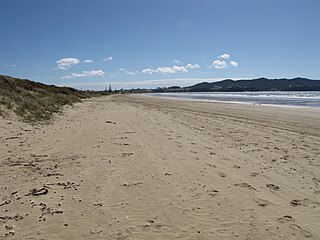
Tokerau Beach is a settlement on the northwestern side of Doubtless Bay on the Karikari Peninsula of Northland, New Zealand.
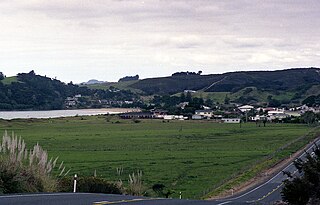
Taipa is a settlement on the southern side of Doubtless Bay in Northland, New Zealand. State Highway 10 runs through it. It is the westernmost of the Taipa-Mangonui string of settlements, and separated from the others by the Taipa River.

Waipu Cove is a locality and bay of Bream Bay in the Whangarei District and Northland Region of New Zealand. It is about 9 km southeast of Waipu and 5 km northwest of Langs Beach. It has a long sandy beach.

Langs Beach is a locality on the shore of Bream Bay in the Whangarei District and Northland Region of New Zealand. It is about 5 km southeast of Waipu Cove and 10 km northwest of Mangawhai Heads.
